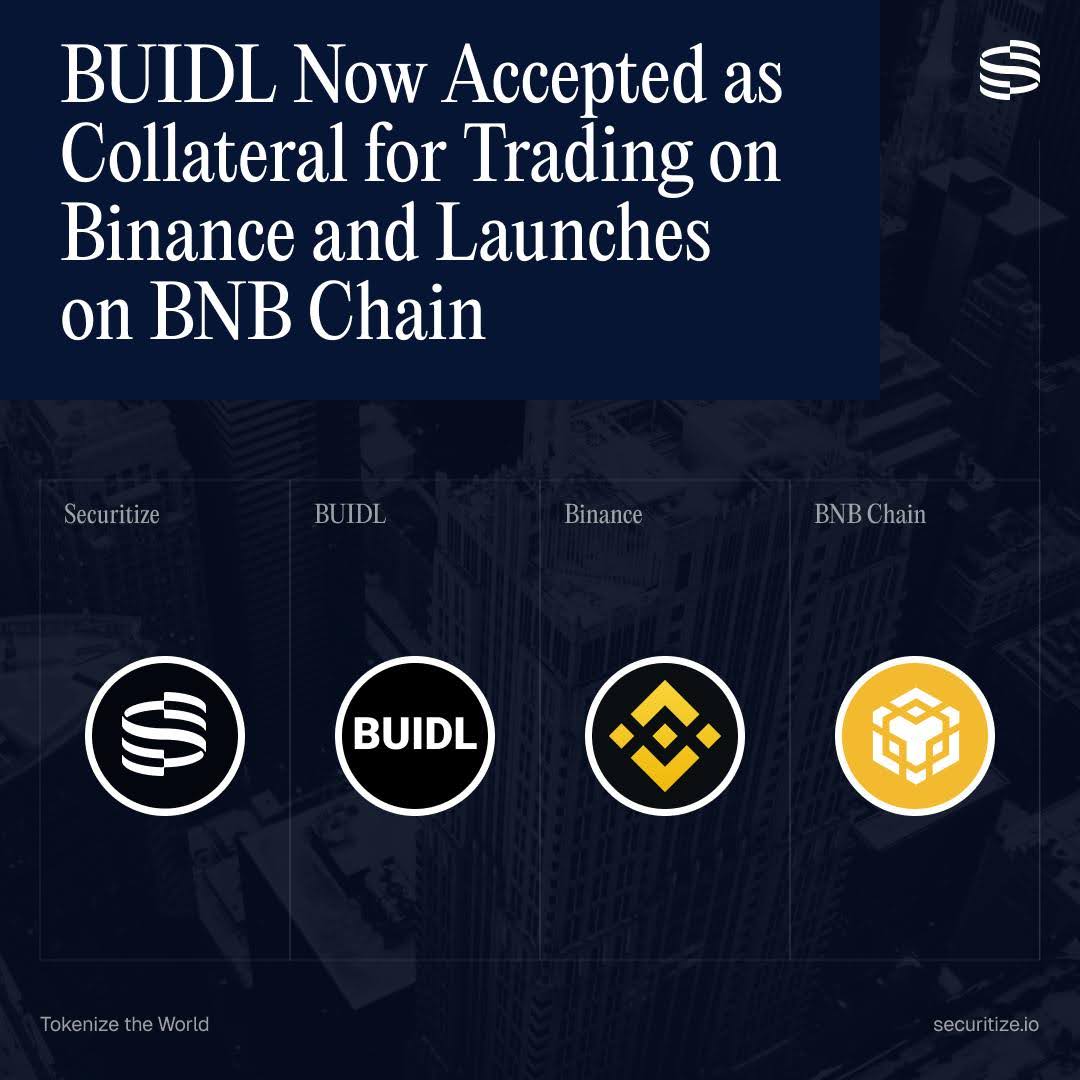Binance Unlocks $500M+ Tokenized Liquidity as BlackRock’s BUIDL Joins Its Collateral System

Key Takeaways:
- Binance now accepts BlackRock’s tokenized BUIDL fund as off-exchange collateral, expanding institutional access to regulated, yield-bearing assets.
- BUIDL is launching a new share class on BNB Chain, strengthening the momentum behind the real-world asset (RWA) tokenization wave.
- The move integrates traditional Treasuries into Binance’s institutional trading framework, aligning crypto markets with conventional capital-markets infrastructure.
Institutional crypto flows are accelerating as Binance brings one of the world’s largest asset managers directly into its collateral ecosystem. By integrating BlackRock’s BUIDL fund, the exchange adds a regulated, yield-generating instrument to its institutional liquidity stack, marking another step in the collision between tokenized Treasuries and on-chain financial markets.
Read More: Binance Wallet Bans 600+ ‘Bot Farm’ Accounts, Claws Back Airdrops, Offers 50% Bounty

A Major Expansion of Tokenized Collateral on Binance
Binance’s decision to accept BUIDL as eligible off-exchange collateral signals how fast tokenized funds are entering mainstream financial rails. The BlackRock USD Institutional Digital Liquidity Fund, tokenized by Securitize, gives institutions exposure to dollar-denominated yields while allowing peer-to-peer transfers and flexible custody. Now, that same exposure can also be deployed as margin for trading.
To institutions, it is a direct benefit: they are free to store BUIDL with a regulated third-party custodian and get exchanged credit on Binance, eliminating direct counterparty risk and not having to move assets onto the exchange. The structure is similar to triparty collateralized models employed in conventional finance, and therefore more comfortable to compliance departments and risk committees.
Catherine Chen, Head of VIP/Institutional at Binance, stated that customers have been requesting more interest earning assets they can pledge without losing liquidity. BUIDL checks the box. It also provides an advantage to Binance during a period when some of the biggest exchanges are competing to provide safer access to the institutional markets.
Why BUIDL Matters in the RWA Tokenization Wave
The debut of BUIDL in 2024 was the first publicly traded tokenized fund on a public blockchain that BlackRock launched, and its rapid usage indicates how quickly tokenization is turning into a building block of crypto capital markets. BUIDL holds short-term U.S. Treasuries and cash equivalents, exactly the type of asset institutions want as collateral because it’s liquid, low-risk, and yield-bearing.
Recognizing this demand, Binance is expanding the ways BUIDL can be used. Accepting it as collateral gives traders the ability to keep exposure to tokenized Treasuries while using that exposure to trade spots, derivatives, or other institutional products.
Robbie Mitchnick, who leads digital assets at BlackRock, said enabling BUIDL to operate across major digital-market infrastructure helps bring the core mechanics of traditional finance into the on-chain environment. His statement reflects a major industry shift: tokenized funds are no longer experiments, they are becoming everyday financial tools.

BUIDL Expands to BNB Chain, Boosting On-Chain Financial Utility
Alongside the collateral integration, BUIDL is launching a new share class on BNB Chain. This matters because BNB Chain offers lower fees, high throughput, and broad developer support, making it an attractive home for programmable financial products.
Sarah Song, Head of Business Development at BNB Chain, emphasized that BUIDL’s arrival enables more complex on-chain strategies, since tokenized Treasuries can now interact directly with DeFi protocols built on BNB Chain including liquidity markets, structured products, and institutional-grade smart-contract systems.
The expansion also increases interoperability. BUIDL already operates across several networks: Ethereum, Polygon, Solana, Avalanche, Arbitrum, Optimism, and others. Adding BNB Chain strengthens its multi-chain footprint and allows institutions to choose the settlement environment that best fits their operational requirements.
Read More: Binance Rolls Out Bubblemaps to Millions of Users, Supercharging On-Chain Transparency
Institutional Trading Gains a Capital-Efficiency Upgrade
Tokenized RWAs are becoming essential tools for institutions that want to scale crypto exposure without adding undue balance-sheet risk. With BUIDL in Binance’s framework, a fund holding short-term Treasuries now acts like a flexible liquidity instrument that can secure leverage, support derivatives exposure, or serve as general trading margin.
How Off-Exchange Collateral Works
Under Binance’s Banking Triparty model, institutions can keep assets in custody with regulated banking partners or with Ceffu, Binance’s crypto-native custody provider. The custodian holds the collateral, and Binance extends trading credit equivalent to the value of the assets.
This structure ensures:
- Secure, off-exchange asset control
- Regulatory alignment and auditability
- Reduced counterparty exposure
- Real-time access to Binance liquidity
Adding BUIDL expands the universe of acceptable collateral, giving institutions more flexibility in how they deploy their balance sheet.
The post Binance Unlocks $500M+ Tokenized Liquidity as BlackRock’s BUIDL Joins Its Collateral System appeared first on CryptoNinjas.
